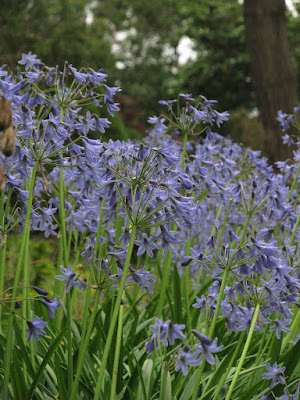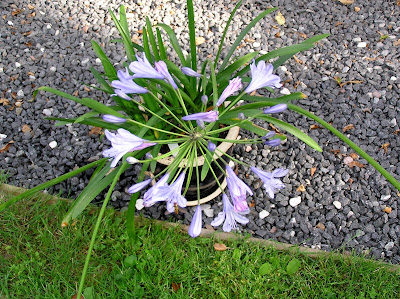Agapanthus campanulatus is found in the Eastern Cape, Lesotho, KwaZulu-Natal, Gauteng and Mpumalanga. It grows in grassy and rocky places, often amongst bracken, and in moist peaty soil at low elevations.
Agapanthus campanulatus also called as African bluebell, African Blue lily, Bell Agapanthus, is a species of the genus Agapanthus. This species was described by Frances Margaret Leighton in 1934.
IDENTIFY AGAPANTHUS CAMPANULATUS PLANT
Agapanthus campanulatus is found in the Eastern Cape, Lesotho, KwaZulu-Natal, Gauteng and Mpumalanga. It grows in grassy and rocky places, often amongst bracken, and in moist peaty soil at low elevations.
African bluebell is deciduous, clump-forming perennial, growing 0.4 to 1 meter tall with slender, glossy green or greyish-green strap-like leaves narrow to a distinct purplish stem-like base, and it produces 6-12 leaves per plant.
African Blue lily blooms in mid- to late summer (December-March) on a long flower stalk with 10 to 30 pale to deep blue flowers with a darker blue stripe in form of a umbel. The fruit is a capsule containing many flat, black, winged seeds.
AGAPANTHUS CAMPANULATUS PLANT CARE AND CULTURE
Cultural information should only be used as a guide, and should be to be adapted to suit you. Your physical location; where you grow your plants, how much time you have to devote to their care, and many other factors, will need to be taken into account. Only then can you decide on the cultural methods that best suit you and your plants.
Light:
Agapanthus campanulatus can be grow as a houseplant in bright light. The plant requires good lighting in the summer, with a lack of light, the flower stalks are extended, and they need support. They grows best at a window with a south, southeast, or southwest orientation. This plant blooms best when grown in full sun.
Temperature:
In summer, the optimal temperature is at around 25℃. In winter a low temperature of 10-12 ℃ is desirable. African bluebell is frost hardy, and should be able to survive in permanent outdoor cultivation in areas with a winter minimum of -7°C, although in regions that dip to -5° C and below for long periods the plants should be mulched thickly with a protective layer of leaves/straw/hessian.
Substrate and growing media:
Plant African Blue lily just deep enough to cover the roots, spacing them about 8” apart. A single plant will fill a 12” pot, or use more in larger pots. Use well-drained potting mix, as they do not tolerate waterlogged soil. For good growth and abundant flowering, this plant requires a nutrient mixture of clay-sod, humus, leaf soil and sand (2: 2: 1: 1).
Young and medium-sized specimens are transplanted every spring, adult plants every 3-4 years. The plant does not like frequent transplants, blooms best in a close pot. When transplanting, be careful, as the rhizomes of Agapanthus are carelessly broken when carelessly applied and the plant may not tolerate the transplant.
Watering:
Keep the plant well watered when growing, but allow it to dry out in winter. Making sure that the substrate does not dry out completely. If watering is excessive, water may stagnate, which leads to acidification of the soil.
Fertilizer:
During the growing season, the plant can be fertilize every 10 days (April to October). In the winter, during the rest period the plant is not fed.
Rest period:
Keep Agapanthus campanulatus outdoors as long as possible in the fall because they need a cold period in order to flower well the next season. However, do not subject your plants to heavy frost (28ºF). In winter the plant should be place indoors in a cool location with bright light such as in a mudroom, by a window in a garage that does not freeze, or in a room that is kept cool (45ºF - 55º F). Keep your plant on the dry side, watering perhaps once a month. If plants are kept too warm during the winter they will force into bloom before summer.
During the winter, reduce watering and do not fertilize during this time. In the spring, after danger of frost has passed, place your plant outdoors, gradually moving them from part sun to full sun, and begin watering and fertilizing regularly.
Propagation:
Agapanthus campanulatus can be propagated from seed or division. Seed should be sown in spring; germination usually takes 1-4 months. It will take 3-5 years to flower from seed. Root bound potted plants can be divided every 4-5 years. Division is best done after flowering, but it can be done any time. Use a very sharp knife to cut the clump into sections, each with roots attached, and pot the sections up. Divisions may not flower until the following year.















COMMENTS